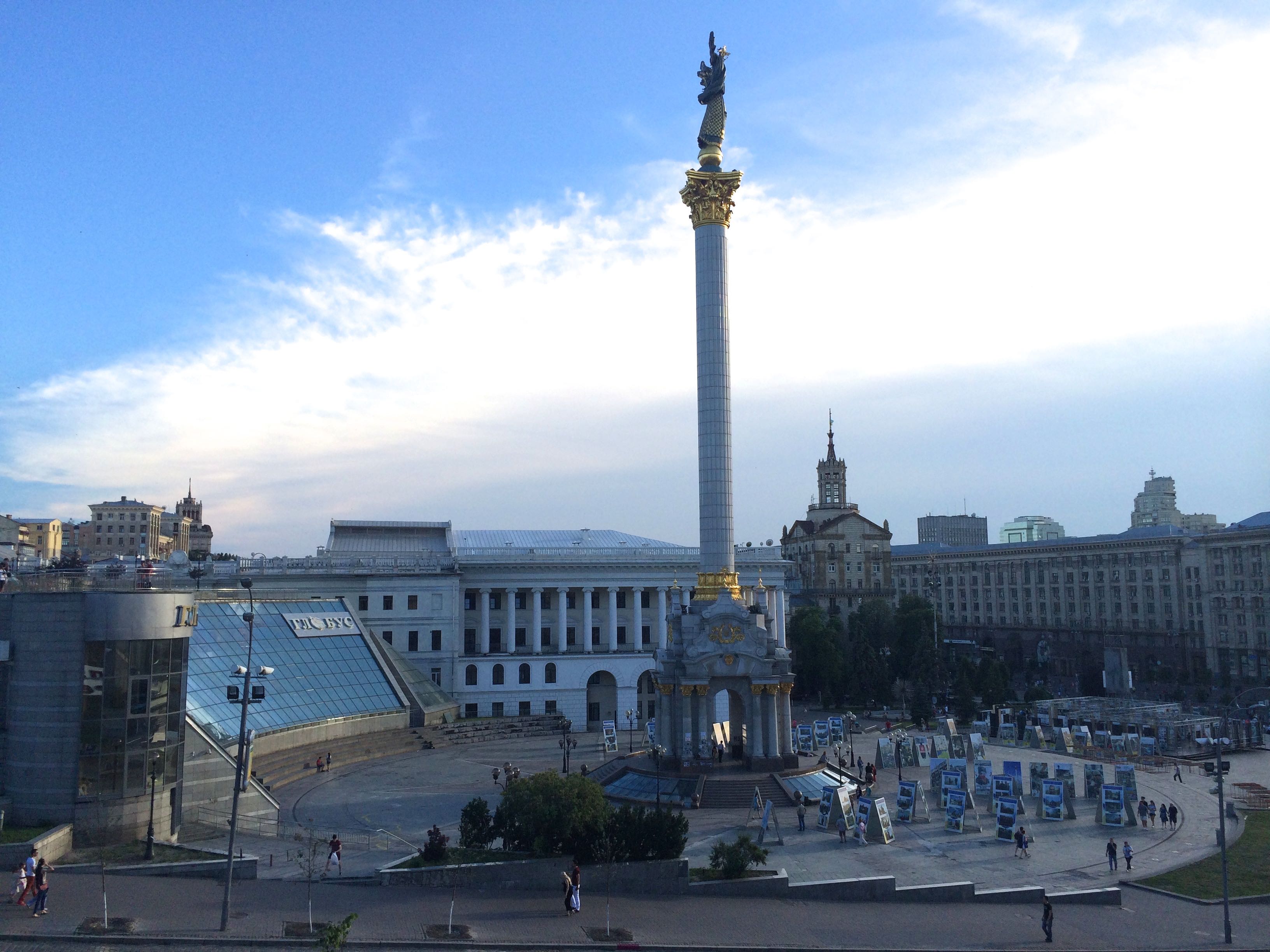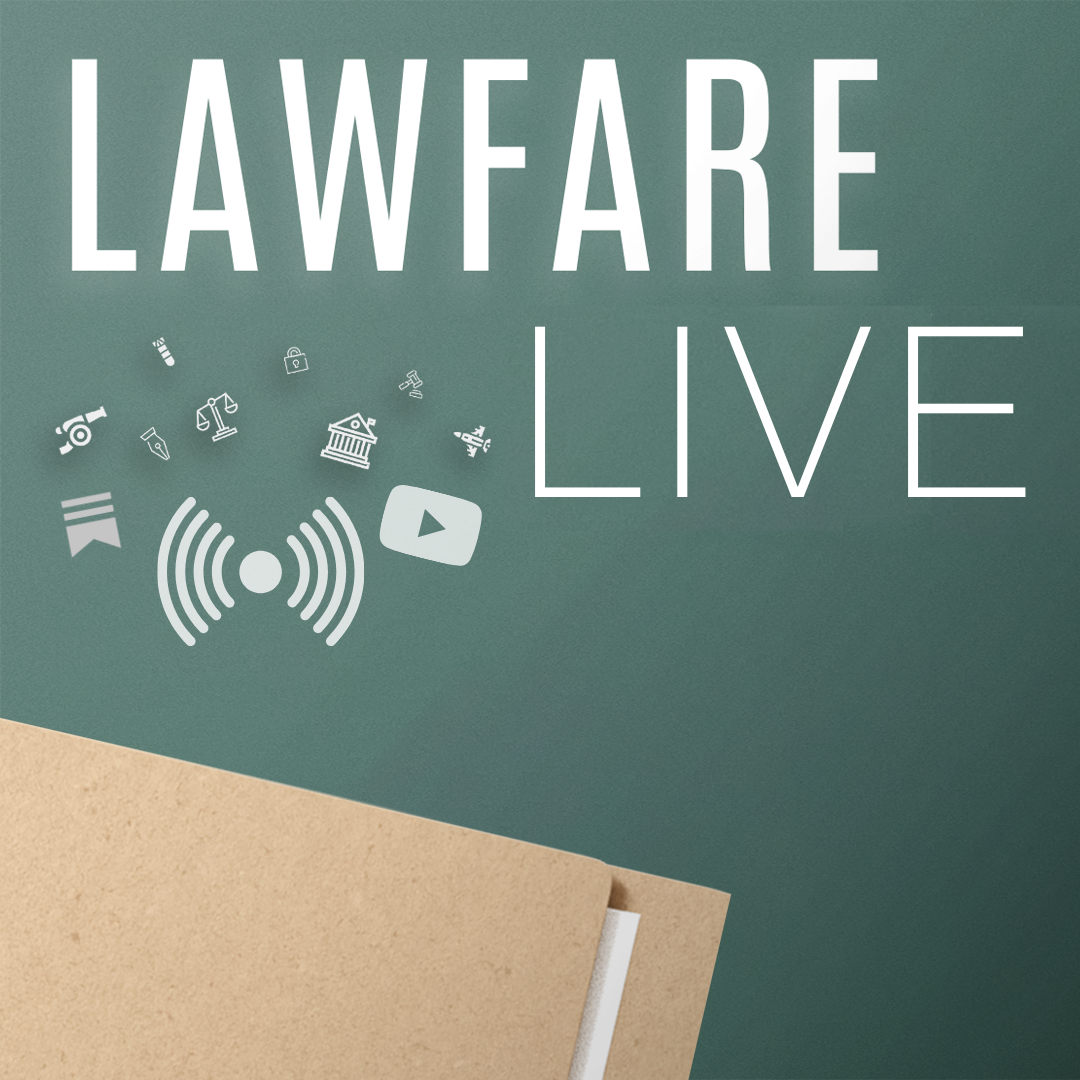Kyiv Dispatch: The View from Ukraine
For the next two months, I’ll be sending dispatches from Kyiv on what’s happening within this country that has become a flash-point in Russia’s relationship with the West. I will report back on my conversations with people, take pictures of the things I see, and to try to give Lawfare readers a flavor of what is happening in the country on the front lines of Vladimir Putin’s confrontation with the United States and Europe.

Published by The Lawfare Institute
in Cooperation With

More than a year after protesters filled the Ukraine’s Maidan, it is hard to imagine the dramatic scenes that defined this square during the revolution. There are still signs: the scattered memorials, picture galleries explaining the revolution, scorch marks on the concrete, and new cobblestones that have replaced those uprooted during the protests. Yet ordinary life has slipped back in.
Along the Maidan’s edges, grizzled soldiers scan the square. They are collecting money for the fight in the East. Other soldiers and police officers are spread across the space, carefully watching the passing hordes. Their presence belies the grim fact that while the Maidan may be calmer, the fight for Ukraine’s future has only moved eastwards.
For the next two months, I’ll be sending dispatches from Kyiv on what’s happening within this country that has become a flash-point in Russia’s relationship with the West. I am in no sense a conventional reporter. I’m a graduate student serving for the summer as a legislative intern in the Ukrainian Parliament. But Benjamin Wittes has asked me to report back on my conversations with people, to take pictures of the things I see, and to try to give Lawfare readers a flavor of what is happening in this country on the front lines of Vladimir Putin’s confrontation with the United States and Europe.
Ukraine’s fighting is far away, and Kyiv is filled with crowded sidewalk cafes and flower shops. Yet every day brings stark reminders of the country’s turmoil.
My commute to work takes me through the Maidan, along a sidewalk lined with pictures of Ukrainians taken from their families too soon.
It goes up a road where makeshift memorials, adorned with flowers and hardhats, mark the spots where protesters were brutally gunned down by government snipers. And it takes me past the spot where I stood a few days ago watching voluntary battalions chanting ultra-nationalist slogans as they marched in military fatigues and face masks.
It continues to Ukraine’s Central Bank, where a gaggle of protesters has camped out, demanding government relief after the hryvnia (Ukraine’s currency) collapsed earlier this year and made it difficult for them to pay back their dollar-denominated debt. And finally, it goes through the doors and into the oriental-rug-lined halls of my committee building. Here Ukrainian Members of Parliament and their staffs are pushing (and being pushed) to reform broad swaths of their economy and institutions. All the while, foreign delegations are arriving weekly to express support, offer advice, and pump money into new projects.
Pick up any newspaper and the headlines reveal just how grim the situation has become. A recent op-ed in the Washington Post asked “Will this be the summer when the West let Ukraine die?” In the East, the fighting continues even after ceasefire agreements. One day, it is six killed, another day it is twelve. The dead now total well over 6,000, with estimates that hundreds of Russian soldiers have been killed alongside the Ukrainians.
Russia, of course, denies any direct involvement in the crisis. It has even taken great measures to quietly hide its own soldiers who were killed in the fighting.
In contrast, Ukrainians are determined to lay out the evidence proving the opposite. Seized Russian tanks are displayed in front of Kyiv’s Rodina Mat statue, which was originally built as an ode to the Soviet Union’s military past.
The signs next to each seized item read: “This item is a material evidence of crimes committed by pro-Russian militant groups supported by the Armed Forces of Russian Federation on the territory of Ukraine.” One volunteer battalion, Dnipro-1, has used drones to document growing Russian bases within Ukraine’s territory.
Nobody quite knows what to expect in the coming weeks. Some analysts suggest that the fronts have solidified and it would not be in the separatists’ or Russia’s interest to push them further. But others whisper in Kyiv’s bustling cafes that as summer grinds on and the mud roads dry up, tanks will be moving and the fighting will take off. Earlier this week, volunteer soldiers called my legislative office to collect money for the fight and for medical supplies. Perhaps out of genuine fear, or perhaps as a fundraising tactic, they expressed the conviction that the Russian-backed separatists were revving up for another big land grab with the strategic center of Mariupol at the center.
The United States and the rest of the world are certainly taking note. But the right balance of diplomacy, economic sanctions, military force, and strong rhetoric is not obvious. Ultimately, it will be Ukrainians who will be building their country and defending their borders. But if Russia is to be restrained, this isn’t just Ukraine’s battle to fight.
Protests Real and Fake
For anyone living in Kyiv, protests quickly become a fairly common part of everyday life. When the Rada (Ukraine’s Parliament) is in session, groups chant nonstop outside of my committee building, waving flags of all colors and insignias. They make speeches for hours, using megaphones to discuss their personal stories about dollar-denominated debt and the installation of cash registers in small businesses.
To a casual American observer, these protestors seem pretty normal, a tangible manifestation of fundamental rights. But there’s more to at least some of these protests than meets the eye.
A few days ago, I stopped by the U.S. Embassy to find protesters standing outside the consular entrance. This group was decidedly anti-American in its message, holding signs berating the United States, including my favorite: “Yankee Go Home.” The entire scene seemed to capture more of a Hugo Chávez vibe than a Ukrainian one. The signs were all written in variations of the same handwriting, with what looked like the same marker. All of the flags were identical.
“It looks like someone gave them a protest kit” my friend commented.
And it did. Enthusiasm was lacking, and anger, if there was any, was certainly not palpable. You can see for yourself what look like the world’s most bored protesters in this video shot by, you guessed it, a Russian news agency. And I wasn’t even sure what exactly they were protesting.
So I decided to ask.
At the front of the line, a teenage boy was clutching an anti-American sign in English. “English?” I asked. He shook his head and turned around. I wondered if he or his friends standing next to him knew what was on their signs . . . or if they even cared.
I tried another group of Ukrainians chatting on the group’s outskirts. A woman just shook her head as I tried to ask what the group was protesting against. The man in the group looked at me quizzically and then answered laughing, “It's an excursion.”
An “excursion” means that this protest likely did not stem from some spontaneous outburst of anti-American sentiment. Rather, it likely came from a group of protestors answering the many signs posted around the city that promise a few U.S. dollars for a couple hours of protest work.
Sometimes, the protestors are bussed. Sometimes, they just arrive at a location where they have been told to meet. A Ukrainian colleague of mine explained that some people even view these protest-for-pay gigs as a kind of part-time job.
Now if these protesters were indeed being paid, that only begs the question of who was paying them?
>But the perverse tactic of paying protesters also affects the way people look at protesters in general. The very uncertainty surrounding whether any given protesters are being paid or not casts a shadow of doubt on all protests. Just knowing that some Ukrainian protesters are paid makes you scan every protesting group, wondering if everyone really is there because he or she truly believes in the cause. There is an obvious difference between real anger and (poorly) paid facsimiles of it, and you can usually tell which is which. But the uncertainty that paid protestors create is corrosive nonetheless.
If Ukraine is to continue to build and protect its democratic foundations, it will need to tackle this head on. A free society requires a variety of views and a freedom of speech, but it also requires empowered citizens, civil society, and journalists ready and able to separate information from misinformation. It will be hard for Ukrainians to shake the past or look to the future, if they are never certain about the present.
Ukraine’s Latest Corruption Museum
Outside the striking metal gates, vendors rent bikes to families, kids beg their parents for ice cream cones, and new brides teeter past in impossibly high heels to take pictures among the spectacular gardens inside. It’s a beautiful day in Ukraine, not a cloud in the sky, and the atmosphere outside Mezhyhirya feels like it could be straight out of New York’s Central Park in the summer.
But this is no ordinary park. It’s former President Yanukovych’s private residence and, according to Ukrainians, it is their newest Museum of Corruption.
I’m at the sprawling Yanukovych estate to attend the first day of a two-day conference on investigative journalism. Entering the grounds, it is hard to believe that this was one man’s private property. Up first is the zoo—complete with ostriches (which Yanukovych explains in this interview doubling as satirical gold), peacocks, a range of exotic birds, chickens, antelopes, and sheep.
Then it’s the greenhouses, private tennis courts, fleets of collector cars, a non-functioning pirate ship, a golf course, and sprawling gardens that stretch 140 hectares down along the Dnieper river.
But the Honka is the centerpiece. The towering house was Yanukovych’s residence, surrounded by lavish gardens and fake Greek ruins.
The house is locked, guarded by a lone soldier, who slouches, looking bored on a bench outside. Tourists press their faces to the windows, peering in at the garish furniture inside. We, like them, will have to be content with our glimpses of the house's interior, having missed the two daily private tours for 200 hryvnia a person (about $10) advertised on a piece of paper taped next to the back door.
This type of extreme extravagance and corruption was one driving force behind the Ukrainian revolution. At a time when Yanukovych had just moved from an official salary of around $24,000 a year as a member of parliament to $100,000 as president, he somehow could afford to spend $38 million euros on new chandeliers for the Honka. His gutting of the Ukrainian economy to enrich himself and his cronies went far past your run-of-the-mill corruption, with estimates that they stole some 14 percent of the country’s annual production. Hundreds of companies, many of them state-owned, may have acted as part of this giant corruption scheme.
However, Mezhyhirya today is more than just a testament to mind-boggling corruption. It is also a representation of Ukraine’s dedicated civil society and journalists. From 2010 through 2013, the country’s journalists and activists would gather on June 6 outside Mezhyhirya’s gates to protest press censorship. When the gates finally opened on February 22, 2014, these journalists flooded in.
In a last minute (and spectacularly amateurish) attempt to dispose of mounds of incriminating documents, Yanukovych’s staff dumped 200 folders with more than 25,000 documents into the estate’s swimming pool and the Dnieper river. Immediately a team of more than 60 volunteers recovered the papers, painstakingly spreading them across the ground to dry them off, and then upload each one onto the website YanukovychLeaks.org to share their contents with the world. Since then, these journalists and their colleagues have held an annual conference on investigative journalism and advocacy at the very spot where these papers once lay.
Just as striking is the orderly spirit that infuses today’s Mezhyhirya. Fountains sprinkle peacefully and families wander around the still-very-manicured gardens. There is no rule breaking here. As we wait outside for our lunch of chicken, salad, and bread, a Ukrainian soldier sternly reminds us to stay off the grass. Even as we stare at the fleets of Yanukovych’s cars—including classic U.S. cars—soldiers stand by, making sure we do not touch anything.
In so many other countries, this type of luxury and tangible evidence of corruption would have been looted or destroyed. Yet my Ukrainian colleague shrugs off my amazement that things are so peaceful and well maintained within the estate. “It was built with the Ukrainian people’s [stolen] money so it makes far more sense to hand it back to the Ukrainian people.”
Behind the festive atmosphere, there are subtle signs that things are not entirely stable. Ukrainian soldiers and their Hummers are spread throughout the grounds, hinting at the estate’s notorious past. Their attire suggests deeper problems. While their uniforms match, by and large, their shoes are a different story. For an army charged not only with protecting Mezhyhirya but also with fighting the Russian-backed separatists in the East, the mismatching footwear is a sign of the military’s ill-preparedness.
As we leave the estate, vendors are packing up for the day. We quickly peruse their goods—magnets, maps, and sunglasses that mostly poke fun at Putin or Yanukovych. For a dollar, I pick up a roll of toilet paper complete with pictures of Putin’s face and Ukrainian obscenities. As I drop the hryvnia in the vendor’s hand and turn to leave, I can't help but notice that the song “Gangster’s Paradise” is playing softly in the background.
American Officials On Parade
If you are an American politician or policymaker right now, there’s a strong possibility that Ukraine is somewhere on your agenda. At least that’s the impression one gets watching the endless parade of U.S. politicians and policymakers touching down in Kyiv.
Perhaps the gold star should go to members of the U.S. Congress. Last month, the big ticket visit was from Senators John McCain, Tom Cotton, and John Barrasso, who toured the country and made headlines in Kyiv and the eastern front. But in total, a whopping 70 members of Congress are estimated to have passed through the country over the past year.
High ranking officials from the State Department too have touched down on the ground, as have members of the administration. Vice President Biden has appeared more than once. And Samantha Power, the U.S. Permanent Representative to the United Nations, spoke recently at Kyiv’s October Palace right outside the Maidan, decrying “Russian aggression” four times.
But with so many U.S. officials passing through the country, what are they all actually doing?
On one hand, these visits reaffirm U.S. support for Ukraine. Some Ukrainians even see this as being one of the United States’ most powerful foreign policy tools. “The constant presence is what we really need,” a former member of parliament told me. “When someone is in the hospital, sending money isn’t as meaningful as showing up with flowers.” This person quickly clarified that Ukraine was certainly “not sick."
Yet, on the other hand, it’s hard to tell what actually comes from these political visits. Each trip is a significant logistical enterprise both for the U.S. Embassy and for the receiving government officials. And, how much these visitors are adding to the discussion seems debatable. “I’ve heard this ten times before,” a Ukrainian colleague bemoaned as we left the Power event.
Certainly, these trips help create a more informed U.S. government that will ideally lead to better policy. The issues running through this part of the world are complex, and more time on the ground will likely only help policymakers to grasp this reality and their possible options. A more cynical view might also suggest that at least for members of Congress, these visits serve to strengthen security and foreign policy credentials by identifying the members with a dream narrative harkening back to more black-and-white, Cold War times.
To be fair, Congress has repeatedly passed bills authorizing hundreds of millions of dollars in military aid to Ukraine. Member pressure on the Obama administration to do something more for supporting and arming Ukraine has been significant.
As the year goes on, more delegations of U.S. officials will surely touch down in the Kyiv Boryspil airport. Ukrainians can only hope the explosion of frequent flier miles will amount to something more meaningful than a few free upgrades.





